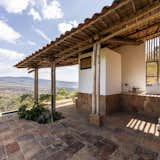How They Pulled It Off: A Rural Vacation Home in Colombia Works With the Sloping Terrain
Welcome to How They Pulled It Off, where we take a close look at one particularly challenging aspect of a home design and get the nitty-gritty details about how it became a reality.
Barichara has been called Colombia’s most beautiful town, with its rural, serene setting, stone streets, and unique building traditions that make it feel "suspended in time, resisting the invasion of modernity," as Gabriel García Márquez described in Love in the Time of Cholera. The town has changed little since the 18th century, with a construction industry relying on traditional methods. Artisans handcraft bricks and tiles, placing them one by one into a furnace, the same way their ancestors once did.
This commitment to Colombo-Colonial architecture, a style characterized by rammed earth walls, stone masonry, and tile roofs, in rural Barichara and the surrounding areas "has an inherent beauty, yet is often restrictive as a method of contemporary spatial experimentation in extreme topographies," says architect Alejandro Saldarriaga, founding principal of Alsar-Atelier.
Saldarriaga, who formed his practice during the pandemic, recently designed a country home in the remote town. "The closest airport is a three-hour drive," he says. And while it’s a trek for tourists, its recognition as a heritage site has attracted people both to visit and build homes.
For this project, a 2,600-square-foot home that reinterprets the Colombo-Colonial vernacular, he was challenged to work with a sloping site with extreme topography. The design separates private and public zones while offering a sense of movement and open vantage points. The proposal doesn't "fight against the terrain but is placed on different levels, distributed from the highest topography to the more public zones," he says. Furthermore, it was done on a budget and came in at under $100,000.
He named the home La Hoja Sobre el Cerro, or "The Leaf on the Hill," to honor the legacy of the area’s architectural history while reinterpreting it with a contemporary, sustainable, and low-tech, low-cost approach.
How they pulled it off: A multilevel home rooted in tradition
- A modern revision led by the past: Intrigued by Barichara’s 100 percent local construction industry, Saldarriaga spent time visiting many construction sites before starting the build. "There’s no glass, and if you want glass you have to bring it in through a larger urban center and that’s unusual due to price." Instead, they rely on locally sourced wood, clay, tile, brick, and stone, along with rammed earth and stucco.
Raumplanian space planning: The home’s design follows the steep terrain rather than competing with it, incorporating the principles of Raumplan, which organizes space through "level changes rather than walls," says the architect. "This generates an open yet differentiated relationship between the kitchen, living room, and terrace. The bedrooms—the most private areas of the home— are at the top of the plan, while the more public zones rest below. Thick "stone-like white walls, analyzed as the secondary element of the Colombo-Colonial aesthetic, serve as structural cores that rest upon stone bases," he adds.
A roof that appears like fallen leaves: A single-pitched roof is typical in Colombo-Colonial homes and here he has added a playful spin with a double slope "tapered in two directions with roofing tile placed diagonally to facilitate water runoff," he says. By incorporating this feature and working with locally sourced materials with minimal material transpiration, the rural home minimizes emissions by 60 percent, all while achieving a balance between legacy and innovation.
"In architecture schools, you are taught to do things through high-tech means," he says. "I think design under low-budget constraints during the pandemic allowed me to find the beauty within the less expensive."
Project Credits:
Design: Alejandro Saldarriaga, Alsar-Atelier / @alsar_atelier
Photography: Mateo Perez
Related Reading:
How They Pulled It Off: Moving a 1970s Craftsman to a New Location
Published
Topics
How They Pulled It OffGet the Dwell Newsletter
Be the first to see our latest home tours, design news, and more.



